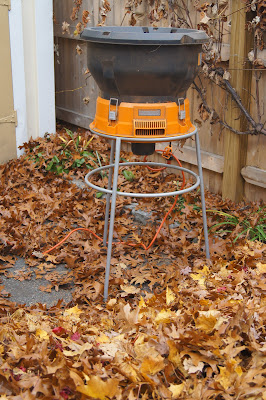 |
| Whole leaves as mulch |
I’ve been evolving a strategy for mulching with fall leaves for more than 30 years. Back when I started my garden, I tried piling whole leaves on garden beds, but it soon became obvious that they wouldn’t stay put. Instead, they blew around and landed on my neighbor’s lawn. Since he raked meticulously almost every day, I could see this was going to be a problem.
That’s why I started using a leaf shredder—essentially a string trimmer in a drum—to chop up fall leaves into mulch.
 |
| Leaf shredder |
The shreds were pretty, they definitely improved the soil as they decomposed, and they didn’t blow around the way whole leaves did. I could use them for mulch in the front yard without making myself unpopular in the neighborhood.
 |
| Shredded leaves make pretty mulch |
For years I shredded leaves every fall to mulch the beds close to the house. By default, the beds farther from the house ended up covered with unshredded leaves.
Last year I heard something that persuaded me to change my approach. Claudia Thompson of Grow Native Massachusetts spoke at my garden club and explained that native insects benefit from leaf litter. By shredding leaves, I was chopping up insect eggs laid on the leaves and eliminating habitat for adult insects that need to overwinter under fallen leaves.
This year instead of shredding the leaves, I’m just raking them from my lawn and my neighbors’, piling them on a tarp, and dragging them over to dump on the garden beds.
 |
| Leaves on their way to backyard beds |
Because I eliminated a whole area of lawn this year and replaced it with a bed of native perennials, I don’t have to worry about errant leaves damaging lawn grass. If leaves from the new bed blow around, they’ll just land on paths of woodchip mulch or bluestone.
 |
| New bed surrounded by paths, no lawn grass |
While I pat myself on the back for upgrading my sustainable practices, I’m also doing a lot less work. Just moving the fallen leaves to the beds is much easier than feeding them into the shredder drum. It was never fun replacing worn filaments, breathing leaf dust, or having my face stung by flying fragments (goggles and heavy gloves were a must). I still plan to shred a few leaves for the front yard.
We’ll see how this new approach works next spring. Conventional wisdom teaches that whole leaves mat down and have to be removed to let perennials reach the light in spring. Claudia said she doesn’t have this problem in her garden of native shade-lovers.
 |
| Will bloodroot flowers be hidden by matted leaves? |
Worst case, I’ll have to move some leaves in spring when it’s warm enough for insects to emerge from winter lodgings. Meanwhile, I can give the shredder a miss and tell myself I’m conducting an important experiment!
No comments:
Post a Comment